Zu Bausatz und Montage:Ein spontaner Zwischen-Bau in einer anstrengenden Zeit - wenn ich etwas "auf Autopilot" bauen möchte, ist eine ARII VF-1 im Fighter-Modus eine sichere Sache. Der Auslöser war, dass mir klar wurde, dass ich, obwohl ich weit über zwanzig VF-1 gebaut hatte, keiner von ihnen eine "Low-Viz"-Lackierung im Stile der US Navy aber der 80er trägt? Also grub ich eine VF-1 aus der Halde und baute den Bausatz weitgehend OOB, allerdings mit einigen Detail-Updates.
Dieses Mal würde das Modell ein ausgefahrenes Fahrwerk und eine offene Kabinenhaube für die Bodendarstellung erhalten. Daher habe ich dem Cockpit Seitenkonsolen und eine Mittelkonsole hinzugefügt. An den Flügeln wurden die Vorflügel und Landeklappen abgesenkt, aber nicht ausgefahren, und für etwas mehr Optik öffnete ich die Spoiler an den Flügeln - weil ihr roter Innenraum einen schönen Kontrast zum ansonsten grauen Flugzeug darstellt (siehe unten).
Charakteristische Blattantennen wurden an den Nasenflanken und auf dem Rücken hinzugefügt, ebenso kleine Radarwarn-Empfänger am Leitwerk, und die Pilotfigur wurde nur für die Schönheitsbilder hinzugefügt.



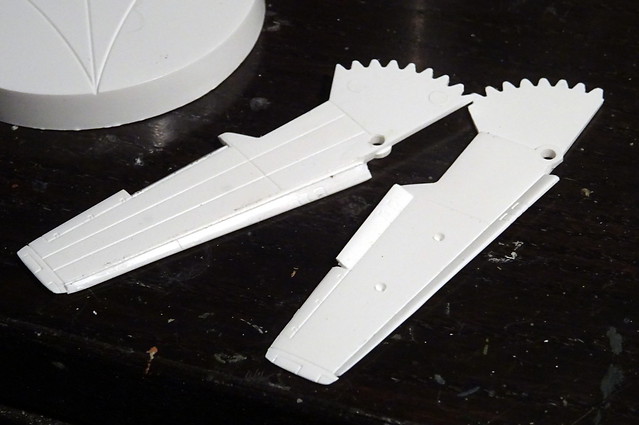

Die Waffenladung stammt zum Teil aus dem Bausatz (die sechs AMM-1-Raketen auf den äußeren Pylonen), innen gab es einen 1:100 AN/ALQ-131-ECM-Behälter (von einer Revell Snap-Fit 1:100 A-10, daher etwas groß) und einer einzelner Marschflugkörper (eine 1:144 AGM-86-ALCM, übrig geblieben von einem Academy B-1B-Kit, allerdings verkehrt herum montiert).
Obwohl das Modell später auf eigenen Beinen stehen sollte, fügte ich die Option hinzu, ein Display (meine quasi-patentierte Drahtkonstruktion) an der Rückseite des Kanonenbehälters anzubringen.
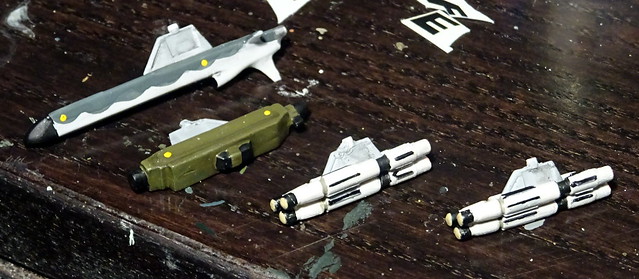 Lackierung und Markierung:
Lackierung und Markierung:Es ist zwar haarspalterisch, aber ich bin mir nicht sicher, ob das "Compass Ghost"- Farbschema für das Macross-Universum
tatsächlich kanonisch ist. Hasegawa bot eine solche "low viz" VF-1 als Option in einem der Fighter-Kits an, aber ich habe in meinen Quellen keine Anzeichen für ein USN-Farbschema gefunden - mit Ausnahme einiger hellgrauer Battroids, die aber nicht wie ein "Compass Ghost"-Flugzeug/-Mecha aussehen. Nach 2009 wurden im Macross-Universum viele VF-1-Modelle offiziell in einem Low-Viz-Schema lackiert - dies wäre jedoch eher eine komplette FS 36440 (Light Gull Grey) Lackierung, plus bunter Vollfarb-Markierungen, und keine völlig gedämpfte, mehrfarbige Grau-Lackierung.
Ich fand die Idee jedoch plausibel und nahm sie auch als Herausforderung an. Folglich wurde das Flugzeug in typischen USN-Farben lackiert: FS 36320 (Dark Compass Ghost Grey) von Modelmaster auf den oberen Flächen und FS 36375 (Light Compass Ghost Grey, Humbrol 127) von unten. Der Bereich um das Cockpit sowie die Kopfeinheit wurden mit FS 35237 (Grey Blue, Humbrol 145), inspiriert von USN F-14 Tomcats, lackiert.
Die Lufteinlässe, die Kanone und einige Details wurden mit Revell 77 (RAL 7012) lackiert, das Fahrwerk glänzend weiß. Das Cockpit war in Standardfarben gehalten, mit mittelgrauem Interieur, schwarzem Schleudersitz, rotbrauner Polsterung und braunen "schwarzen Boxen". Als krassen Kontrast zu der komplett grauen Außenhaut habe ich die Innenseiten der Spoiler auf den Flügeln hellrot lackiert (Revell 330, RAL 3000 Feuerrot) und den abgesenkten Vorflügeln ebenfalls dünne rote Aufkleberstreifen hinzugefügt. Subtil, kommt aber m.E. gut.
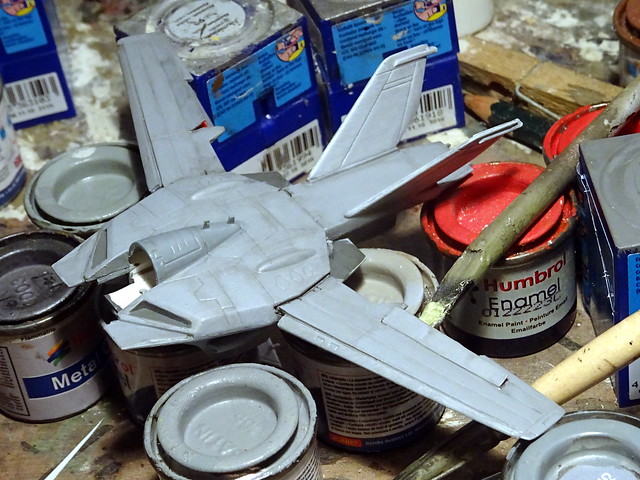


Viele Markierungen wie die Rondelle und der Modex wurden mit einem Tintenstrahldrucker auf klarem Decalblatt entworfen und gedruckt. Alle anderen hellen Markierungen wurden durch graue Alternativen aus der Decal-Restebox ersetzt. Die Blitzmarkierungen auf den Flossen gehören zu einer malaysischen MiG-29, die einem Begemot-Sheet entnommen wurden.
Nach dem Bemalen erhielt das Modell eine leichte schwarze Tusche-Wäsche und die gravierten Paneellinien wurden mit einem sehr weichen Bleistift nachgezeichnet. Schließlich wurde das Kit mit mattem Acryllack versiegelt (Italeri).


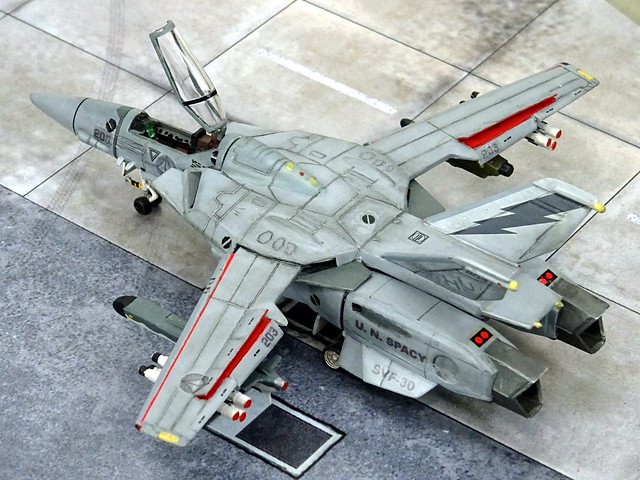
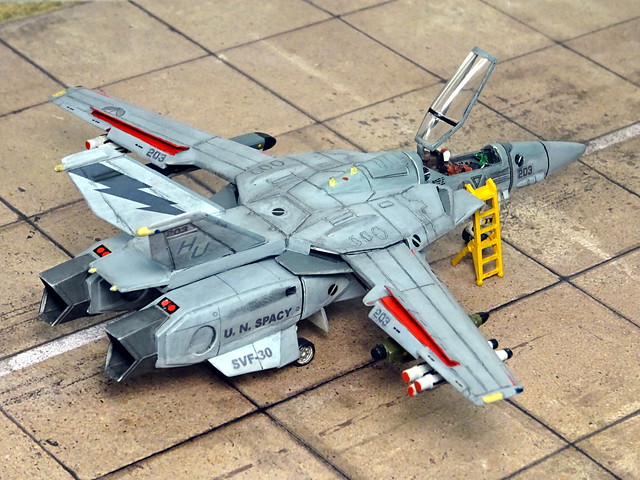
Ich vermute, dass ich diesen Bausatz vermutlich mit verbundenen Augen bauen könnte, und die ganze Angelegenheit war in nur drei Tagen abgeschlossen, da das Farbschema selbst nicht komplex war. Das Ergebnis ist jedoch interessant und bildet einen schönen Kontrast zu den normalerweise sehr hellen